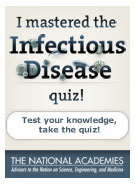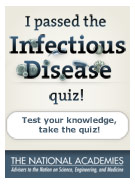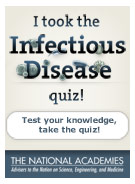
What You Need To Know About Infectious Disease
What do you know about infectious disease?
Since the beginning of the 20th century, the number of people in the world has:
-
Sorry, that’s incorrect.
Since the beginning of the 20th century the number of people in the world has more than quadrupled—from 1.6 billion to nearly 7 billion—and world population is expected to rise to well over 9 billion by 2050.
-
Sorry, that’s incorrect.
Since the beginning of the 20th century the number of people in the world has more than quadrupled—from 1.6 billion to nearly 7 billion—and world population is expected to rise to well over 9 billion by 2050.
-
Correct!
Since the beginning of the 20th century the number of people in the world has more than quadrupled—from 1.6 billion to nearly 7 billion—and world population is expected to rise to well over 9 billion by 2050.
Which reproduce the fastest:
-
Sorry, that’s incorrect.
Viruses reproduce the fastest. Humans produce a new generation every 20 years or so; bacteria do it every 20 to 30 minutes, and viruses even faster.
-
Sorry, that’s incorrect.
Viruses reproduce the fastest. Humans produce a new generation every 20 years or so; bacteria do it every 20 to 30 minutes, and viruses even faster.
-
Correct!
Viruses reproduce the fastest. Humans produce a new generation every 20 years or so; bacteria do it every 20 to 30 minutes, and viruses even faster.
Which of the following is not a viral disease:
-
Sorry, that’s incorrect.
Trichinosis is not a viral disease. It is caused by a helminth (parasitic worm) found in undercooked meat, not by a virus.
-
Sorry, that’s incorrect.
Trichinosis is not a viral disease. It is caused by a helminth (parasitic worm) found in undercooked meat, not by a virus.
-
Correct!
Trichinosis is not a viral disease. It is caused by a helminth (parasitic worm) found in undercooked meat, not by a virus.
True or False: Scientists believe that hot weather may speed up both the breeding cycle of mosquitoes and replication of the virus in insects’ guts.
-
Correct!
Scientists believe that hot weather may speed up both the breeding cycle of mosquitoes and replication of the virus in insects’ guts.
-
Sorry, that’s incorrect.
Scientists believe that hot weather may speed up both the breeding cycle of mosquitoes and replication of the virus in insects’ guts.
Which of the following is NOT a type of infectious agent?
-
Sorry, that’s incorrect.
White blood cells are not a type of infectious agent. Part of the immune system, white blood cells fight infection rather than cause it.
-
Sorry, that’s incorrect.
White blood cells are not a type of infectious agent. Part of the immune system, white blood cells fight infection rather than cause it.
-
Correct!
White blood cells are not a type of infectious agent. Part of the immune system, white blood cells fight infection rather than cause it.
-
Sorry, that’s incorrect.
White blood cells are not a type of infectious agent. Part of the immune system, white blood cells fight infection rather than cause it.
About how much of its fish and seafood does the United States import?
-
Sorry, that’s incorrect.
The United States imports more than 80 percent of its fish and seafood. About 20 percent of its fresh vegetables and 50 percent of its fresh fruits are imported. As wealthy nations demand such foods year-round, the increasing reliance on producers abroad means that food may be contaminated during harvesting, storage, processing, and transport—long before it reaches overseas markets.
-
Sorry, that’s incorrect.
The United States imports more than 80 percent of its fish and seafood. About 20 percent of its fresh vegetables and 50 percent of its fresh fruits are imported. As wealthy nations demand such foods year-round, the increasing reliance on producers abroad means that food may be contaminated during harvesting, storage, processing, and transport—long before it reaches overseas markets.
-
Correct!
The United States imports more than 80 percent of its fish and seafood. About 20 percent of its fresh vegetables and 50 percent of its fresh fruits are imported. As wealthy nations demand such foods year-round, the increasing reliance on producers abroad means that food may be contaminated during harvesting, storage, processing, and transport—long before it reaches overseas markets.
True or False: The clearing and settlement of tropical rainforests has exposed woodcutters, farmers, and ecotourists to new vector-borne diseases.
-
Correct!
The clearing and settlement of rainforests has exposed woodcutters, farmers, and ecotourists to new vector-borne diseases.
-
Sorry, that’s incorrect.
The clearing and settlement of tropical rainforests has exposed woodcutters, farmers, and ecotourists to new vector-borne diseases.
Each year, how many Americans become infected by what they eat?
-
Sorry, that’s incorrect.
Each year about 76 million Americans—or one in four—become infected by what they eat. Approximately 325,000 are hospitalized. More than 5,000 (14 a day) die.
-
Sorry, that’s incorrect.
Each year about 76 million Americans—or one in four—become infected by what they eat. Approximately 325,000 are hospitalized. More than 5,000 (14 a day) die.
-
Correct!
Each year about 76 million Americans—or one in four—become infected by what they eat. Approximately 325,000 are hospitalized. More than 5,000 (14 a day) die.
True or False: Most infectious diseases are not impacted by changes in the environment.
-
Sorry, that’s incorrect.
Most infectious diseases are impacted by changes in the environment. Malaria, dengue, and viral encephalitis infections, for example, are highly sensitive to environmental changes.
-
Correct!
Most infectious diseases are impacted by changes in the environment. Malaria, dengue, and viral encephalitis infections, for example, are highly sensitive to environmental changes.
Thank you for taking our quiz.
Place this badge on your Facebook page to show your friends what you know about infectious disease.
Place this badge on your Facebook page to show your friends what you know about infectious disease.
OR, get a higher score to unlock a different badge.
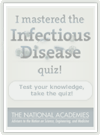
Place this badge on your Facebook page to show your friends what you know about infectious disease.
OR, get a higher score to unlock a different badge.
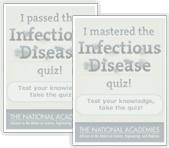
Explore Other Topics
Disease Watchlist
Infectious Disease Defined
- Globalization
The process by which regional economies, societies, and cultures are becoming integrated through a global network of trade, migration, communication, and the spread of new technology.
